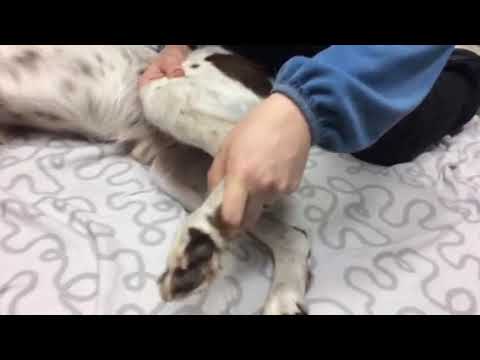Laurie's Blogs.
Dec 2018
Athletic dog with excessive stifle rotation

Hey Laurie,
I have an athletic dog (agility competitor) that has had very slowly increasing amounts of internal rotation of the tibia on PROM of L stifle over the last year..... I had them doing exercises to externally rotate tibia actively to see if it was just a muscle imbalance (ie: femur held in ext rot and tibia compensating). And it got better.
But then today I feel like his resting position in laying was significantly more int rot and in PROM it just kept going....
Cranial caudal integrity feels on point. MCL/LCL stress tests seem okay (but I don’t do these often in dogs so I maybe missing something). And functionally he is fine as he is a super wound up ‘type 2B’ muscles, that actively hold that stifle in neutral. BUT I feel like something is breaking down and changing.... I have had a couple dogs with extreme lax int/ext rot that I keep meaning to ask your thoughts on it.
I am just wondering if I need to get her to back off on how much they do.
Thanks for your help,
S.
Video: https://youtu.be/OGLViJndnfA
-------------
REPLY...
Hey S,
Apologies for the tardy reply. Honestly, I have been hoping that an answer would hit me, but it hasn’t. I watched all 3 of the videos, including the one where you measured and they measured equal in tibial rotation. Tibial rotation isn’t a number that has ever been studied in dogs.
So I did a pubmed search on tibial rotation & athletes. I found just a handful of things, related to CCL and tibial rotation. One that found that women had more tibial rotation laxity than men (big surprise).
https://www.ncbi.nlm.nih.gov/pubmed/18383181
So, I question if you have noticed this from a time if / when Red E was neutered… Is he neutered?
Planting and cutting motions result in increases in Tibial Rotation…
https://www.ncbi.nlm.nih.gov/pubmed/19110433
So, you might be right in that his activity level and ‘job’ in playing agility is causing / allowing for an increase in rotational abilities. Because rotation is only going to be restricted by soft tissue structures - ligaments, joint capsule (slightly), tendons, and the meniscus - there is the potential for these structures to get stretched out (all but the meniscus that is). As such, there quite likely is an increased chance of CCL tear.
Another study found that using a neoprene brace or rigid brace both reduced internal rotation… but I’m not sure that’s what you want to do on a healthy dog (rigid brace), and the stretchy ones don’t stay up.
So, what to do:
Does he back off? Will it change it?
Maybe…
Will it matter?
Maybe…
Lots of unknowns.
However, it might be worthwhile to get Jane to keep a training diary. What was done on each day of the week? How many hours training?
How many jumps? Practice runs?
How often in a week would he be doing these cut and turns?
There is a thought out there that many people are over training their dogs - or doing too much of one thing, not enough of another…
Maybe this is an interesting place to start!
Happy to keep brain storming!
Laurie
YOUR TURN... SEND ME YOUR THOUGHTS ON THIS TOPIC!!!


